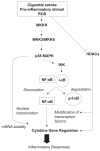Identifying targets for COPD treatment through gene expression analyses
- PMID: 18990963
- PMCID: PMC2629979
- DOI: 10.2147/copd.s1758
Identifying targets for COPD treatment through gene expression analyses
Abstract
Despite the status of chronic obstructive pulmonary disease (COPD) as a major global health problem, no currently available therapies can limit COPD progression. Therefore, an urgent need exists for the development of new and effective treatments for COPD. An improved understanding in the molecular pathogenesis of COPD can potentially identify molecular targets to facilitate the development of new therapeutic modalities. Among the best approaches for understanding the molecular basis of COPD include gene expression profiling techniques, such as serial analysis of gene expression or microarrays. Using these methods, recent studies have mapped comparative gene expression profiles of lung tissues from patients with different stages of COPD relative to healthy smokers or non-smokers. Such studies have revealed a number of differentially-regulated genes associated with COPD progression, which include genes involved in the regulation of inflammation, extracellular matrix, cytokines, chemokines, apoptosis, and stress responses. These studies have shed new light on the molecular mechanisms of COPD, and suggest novel targets for clinical treatments.
Figures


Similar articles
-
Klotho expression is reduced in COPD airway epithelial cells: effects on inflammation and oxidant injury.Clin Sci (Lond). 2015 Dec;129(12):1011-23. doi: 10.1042/CS20150273. Epub 2015 Jul 10. Clin Sci (Lond). 2015. PMID: 26201096 Free PMC article.
-
Genes and gene ontologies common to airflow obstruction and emphysema in the lungs of patients with COPD.PLoS One. 2011 Mar 15;6(3):e17442. doi: 10.1371/journal.pone.0017442. PLoS One. 2011. PMID: 21423603 Free PMC article.
-
Comprehensive gene expression profiles reveal pathways related to the pathogenesis of chronic obstructive pulmonary disease.Proc Natl Acad Sci U S A. 2004 Oct 12;101(41):14895-900. doi: 10.1073/pnas.0401168101. Epub 2004 Oct 5. Proc Natl Acad Sci U S A. 2004. PMID: 15469929 Free PMC article.
-
Oxidative stress and gene transcription in asthma and chronic obstructive pulmonary disease: antioxidant therapeutic targets.Curr Drug Targets Inflamm Allergy. 2002 Sep;1(3):291-315. doi: 10.2174/1568010023344607. Curr Drug Targets Inflamm Allergy. 2002. PMID: 14561194 Review.
-
Role of apoptosis in the pathogenesis of COPD and pulmonary emphysema.Respir Res. 2006 Mar 30;7(1):53. doi: 10.1186/1465-9921-7-53. Respir Res. 2006. PMID: 16571143 Free PMC article. Review.
Cited by
-
The Effect of Bone Marrow Mononuclear Cells on Lung Regeneration and Apoptosis in a Simple Model of Pulmonary Emphysema.Int J Stem Cells. 2016 May 30;9(1):145-51. doi: 10.15283/ijsc.2016.9.1.145. Int J Stem Cells. 2016. PMID: 27426096 Free PMC article.
-
Personalized Analysis by Validation of Monte Carlo for Application of Pathways in Cardioembolic Stroke.Med Sci Monit. 2017 Feb 24;23:994-1000. doi: 10.12659/msm.899690. Med Sci Monit. 2017. PMID: 28232661 Free PMC article.
-
Dynamics of T Cell-Mediated Immune Signaling Network During Pathogenesis of Chronic Obstructive Pulmonary Disease.Yonsei Med J. 2025 Jun;66(6):354-365. doi: 10.3349/ymj.2024.0227. Yonsei Med J. 2025. PMID: 40414827 Free PMC article.
-
Identification of Putative Regulatory Alterations Leading to Changes in Gene Expression in Chronic Obstructive Pulmonary Disease.Mol Cells. 2019 Apr 30;42(4):333-344. doi: 10.14348/molcells.2019.2442. Mol Cells. 2019. PMID: 31085807 Free PMC article.
-
Integrative genomics of chronic obstructive pulmonary disease.Biochem Biophys Res Commun. 2014 Sep 19;452(2):276-86. doi: 10.1016/j.bbrc.2014.07.086. Epub 2014 Jul 29. Biochem Biophys Res Commun. 2014. PMID: 25078622 Free PMC article. Review.
References
-
- Akhurst RJ. Large- and small-molecule inhibitors of transforming growth factor-beta signaling. Curr Opin Investig Drugs. 2006;7:513–21. - PubMed
-
- Barnes PJ, Adcock IM, Ito K. Histone acetylation and deacetylation: importance in inflammatory lung diseases. Eur Respir J. 2005;25:552–63. - PubMed
-
- Barnes PJ, Hansel TT. Prospects for new drugs for chronic obstructive pulmonary disease. Lancet. 2004;364:985–96. - PubMed
-
- Barnes PJ, Shapiro SD, Pauwels RA. Chronic obstructive pulmonary disease: molecular and cellular mechanisms. Eur Respir J. 2003;22:672–88. - PubMed
-
- Barnes PJ. Novel approaches and targets for treatment of chronic obstructive pulmonary disease. Am J Respir Crit Care Med. 1999;160:S72–79. - PubMed
Publication types
MeSH terms
Substances
Grants and funding
LinkOut - more resources
Full Text Sources
Other Literature Sources
Medical

